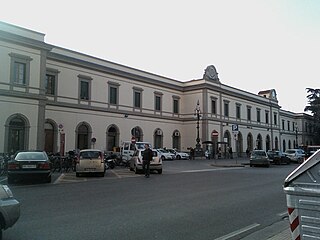
The province of Florence was a province in the northeast of Tuscany region of Italy. The city or comune of Florence was both the capital of the province of Florence, and of the Region of Tuscany. It had an area of 3,514 square kilometres (1,357 sq mi) and a population of 1,012,180 as of 31 December 2014. The territory of the province was the birthplace of the Italian Renaissance.
Beyond Florence, there are nine other provinces in the region of Tuscany, named for the largest city in, and capital of, the respective province. Taken together, they offer an intense musical life.

Calenzano is a comune (municipality) in the Metropolitan City of Florence in the Italian region Tuscany, located about 11 kilometres (7 mi) northwest of Florence. As of 31 December 2004, it had a population of 15,557 and an area of 76.9 square kilometres (29.7 sq mi).

Coop is a system of Italian consumers' cooperatives which operates one of the largest supermarket chains in Italy. Its headquarters are located in Casalecchio di Reno, Province of Bologna.

Tuscan wine is Italian wine from the Tuscany region. Located in central Italy along the Tyrrhenian coast, Tuscany is home to some of the world's most notable wine regions. Chianti, Brunello di Montalcino and Vino Nobile di Montepulciano are primarily made with Sangiovese grape whereas the Vernaccia grape is the basis of the white Vernaccia di San Gimignano. Tuscany is also known for the dessert wine Vin Santo, made from a variety of the region's grapes. Tuscany has forty-one Denominazioni di origine controllata (DOC) and eleven Denominazioni di Origine Controllata e Garantita (DOCG). In the 1970s a new class of wines known in the trade as "Super Tuscans" emerged. These wines were made outside DOC/DOCG regulations but were considered of high quality and commanded high prices. Many of these wines became cult wines. In the reformation of the Italian classification system many of the original Super Tuscans now qualify as DOC or DOCG wines but some producers still prefer the declassified rankings or to use the Indicazione Geografica Tipica (IGT) classification of Toscana. Tuscany has six sub-categories of IGT wines today.

Tuscany is a region in central Italy with an area of about 23,000 square kilometres and a population of about 3.8 million inhabitants. The regional capital is Florence (Firenze).

The Viareggio–Florence railway is a line built between 1848 and 1890 connecting the Tuscan cities of Florence, Prato, Pistoia, Lucca and Viareggio. The first section from Florence to Pistoia was named in honour of Princess Maria Antonia of the Two Sicilies, wife of Leopold II, Grand Duke of Tuscany, who had already been honoured in the naming of the Leopolda railway from Florence to Livorno. It is fully electrified at 3,000 V DC. Passenger traffic is managed by Trenitalia.

The Pisa–Lucca railway is a line that was built in 1846 connecting the Tuscan cities of Pisa and Lucca. It is fully electrified at 3,000 V DC. Passenger traffic is managed by Trenitalia.

The Pistoia–Bologna railway is an Italian railway connecting Bologna to Pistoia and was the first line through the Apennines between Tuscany and Emilia-Romagna. It is also known in Italian as the Ferrovia Porrettana or the Transappenninica ("trans-Apennines"). It was officially called the Strada ferrata dell'Italia Centrale and was officially inaugurated by King Victor Emmanuel II in 1864.

Pistoia railway station is the station of Pistoia in Piazza Dante. It is on the Viareggio–Florence railway, which connects Florence and Viareggio and it is at the beginning of the Porrettana railway to Bologna.

Firenze Rifredi railway station, or Florence Rifredi railway station, serves the city and comune of Florence, in the region of Tuscany, central Italy. It is the third most important railway station in Florence, after Firenze Santa Maria Novella and Firenze Campo di Marte. It also forms part of the traditional Bologna–Florence railway, and the railways linking Florence with Viareggio, and Pisa and Livorno, respectively.

The Metropolitan City of Florence is an administrative division called metropolitan city in the Tuscany region of Italy. Its capital is the city of Florence. It replaced the province of Florence. It was first created by the reform of local authorities and then established by the Law 56/2014. It has been operative since 1 January 2015.

Cassa di Risparmio di Lucca Pisa e Livorno S.p.A. was an Italian saving bank based in Lucca. It was a subsidiary of Banco Popolare and currently a sub-division and brand of the group Banco BPM.
Cassa di Risparmio di Pisa is a former Italian savings bank and charity organization, based in Pisa, Tuscany. The bank was spin off into a banking foundation and a Società per Azioni in 1992.
Cassa di Risparmi di Livorno is a former Italian regional bank and charity organization, based in Livorno, Tuscany. In 1992 the organization was split into a limited company and a banking foundation Fondazione Cassa di Risparmi di Livorno.
Cassa di Risparmio di Pistoia e della Lucchesia is an Italian regional bank based in Pistoia, Tuscany. The bank was a subsidiary of Banca CR Firenze, with Intesa Sanpaolo as the ultimate holding company.
The following is a timeline of the history of the city of Pisa in the Tuscany region of Italy.
The following is a timeline of the history of the city of Prato in the Tuscany region of Italy.
This page is based on this
Wikipedia article Text is available under the
CC BY-SA 4.0 license; additional terms may apply.
Images, videos and audio are available under their respective licenses.















